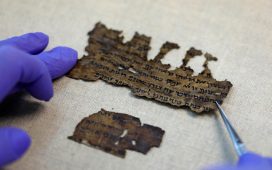Archaeologists have unearthed chilling new evidence of a dark period of brutality at the heart of the ancient biblical city of Gezer, captivating scholars for generations.
Using state-of-the-art radiocarbon dating techniques, experts have probed deep into the history of Gezer in Israel, a site steeped in biblical lore.
The storied city of Gezer, chronicled in Egyptian texts, Assyrian annals, and numerous biblical references, has long been a treasure trove of historical conflict, culture, and renewal. Yet, a groundbreaking study in PLOS ONE casts doubt on some aspects of Gezer’s documented past, uncovering a series of catastrophic events and reconstructions that occurred between the 13th and 9th centuries BCE.
The team analysed 35 organic specimens, predominantly seeds, from the stratified debris of Gezer, revealing over four centuries of tumultuous change indicative of violent conflicts and changing rulers, as evidenced by the city’s multiple phases of destruction and rebuilding. Each specimen contributed to piecing together the complex narrative of Gezer’s repeated cycles of prosperity and ruin.
The research highlighted that “most walls of the administrative building had fallen in the same direction (westward), and the structure was buried in up to 1.5 meters of mudbrick debris; concentrations of boulders filled some rooms,” painting a vivid picture of the calamity that befell the city, reports the Mirror US.
The sudden ruin seemed to have taken the city’s residents by surprise, as the building was found largely vacant. The research team also unearthed evidence corroborating the Biblical narrative of the ancient Egyptian king Shishak’s role in Gezer’s downfall, thereby affirming Shishak’s existence as the first Egyptian monarch named in the Bible.
The timing of Shishak’s reign of destruction coincides with the radiocarbon dates, indicating that the ancient city met a swift and abrupt end.
However, not all connections between Gezer’s archaeological record and ancient texts have withstood the test of time, as discrepancies in the data challenge the timeline and alleged association between Gezer’s fall and the campaign of Hazael, an ancient ruler first referenced in 1 Kings 19:15-17.
“These dates suggest, for example, that the correlation of a certain destructive episode with the actions of the pharaoh Merneptah is plausible, while the proposed link between another such episode and the campaign of Hazael is not,” stated the study’s press release.
While Hazael’s campaign may have been a significant historical event, it appears this is not reflected in the city’s archaeology.
This revelation follows research suggesting a stone carved nearly 1,700 years ago was discovered in the precise area where Jesus is believed to have performed his miracle of walking on water.
A slab inscribed with Ancient Greek characters could potentially alter our perception of the Roman Empire’s reach. The basalt stone, unearthed in Upper Galilee at Abel Beth Maacah, is believed to have been a territorial marker during the period of Roman rule.
Interestingly, this discovery indicates that two hitherto unknown towns – Tirathas and Golgol – were under Roman control, unlike Gezer.
The stone, estimated to be 1,720 years old, harks back to the reign of Caesar Marcus Aurelius Alexander, a name that may resonate with aficionados of the cinematic masterpiece Gladiator.











